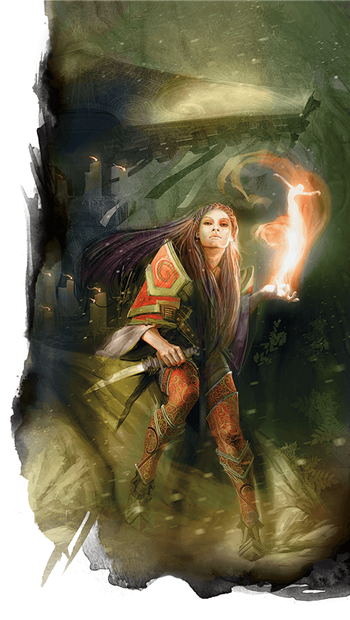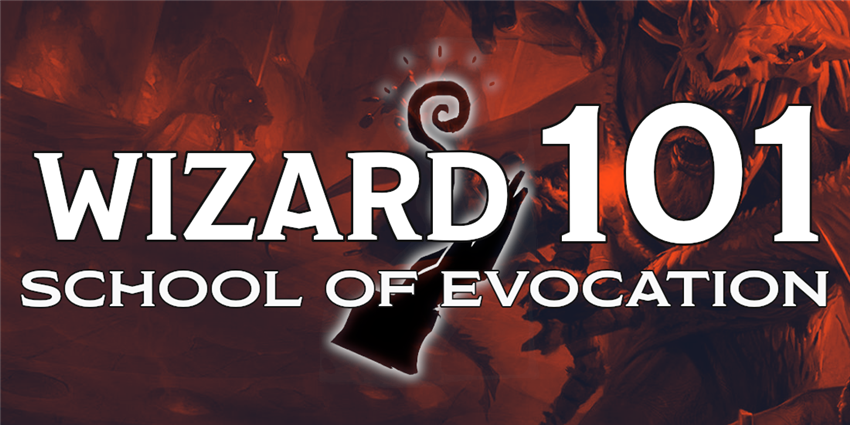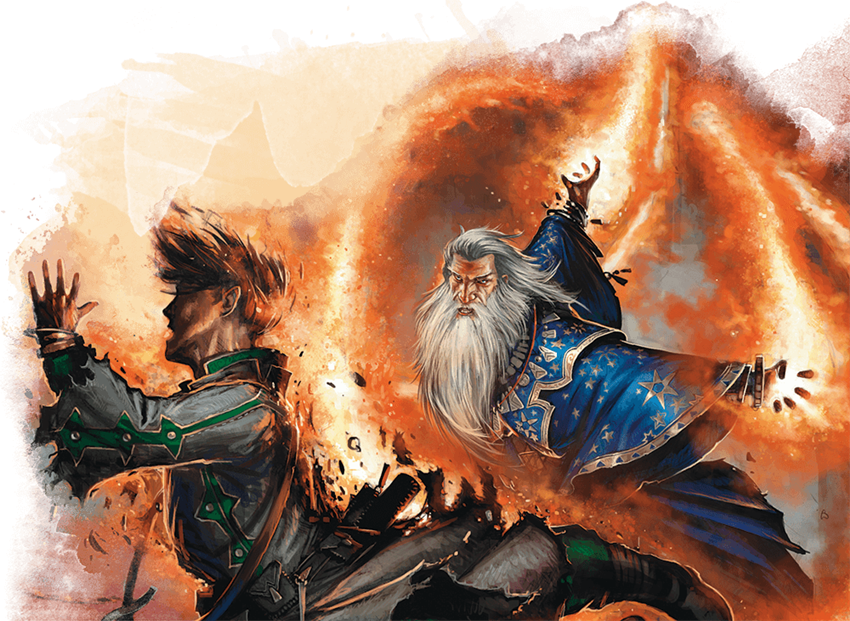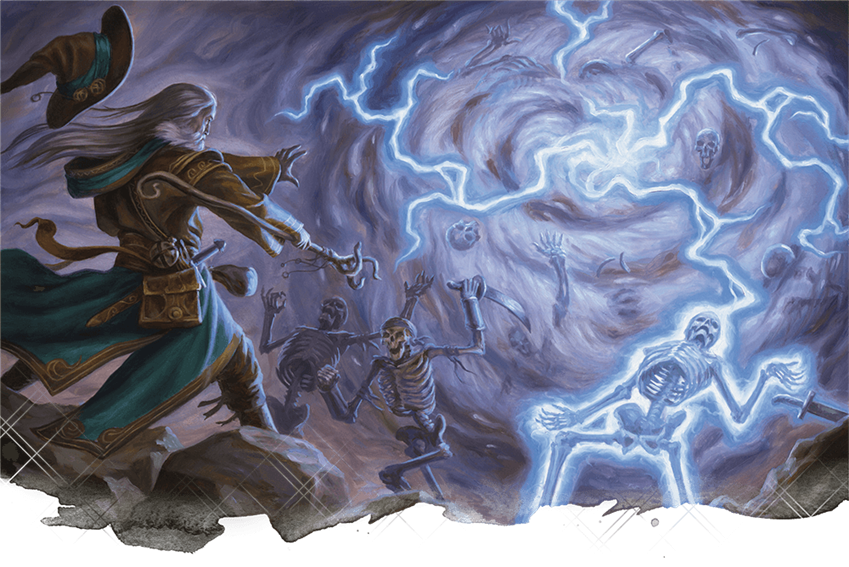 Class is in session, and my friends, it’s time to blow stuff up. Fire, cold, acid, lightning, and poison—oh my. As an evoker—that is a wizard who studies the magical School of Evocation—you are an adept in the art of arcane destruction. Whether you pick a single element to focus in or spread your interests across the entire spectrum of elemental annihilation, evocation is the best pick for wizards that long to lay their enemies low with sheer, unstoppable damage.
Class is in session, and my friends, it’s time to blow stuff up. Fire, cold, acid, lightning, and poison—oh my. As an evoker—that is a wizard who studies the magical School of Evocation—you are an adept in the art of arcane destruction. Whether you pick a single element to focus in or spread your interests across the entire spectrum of elemental annihilation, evocation is the best pick for wizards that long to lay their enemies low with sheer, unstoppable damage.
Story of the School of Evocation
“You’re studying to learn the secrets of fireball, are you?” said one wizard to another. The two wizards stood in the middle of a grassy courtyard surrounded by white marble pillars. The yard was filled with the ambient sounds of instruction and the scribbling of quills emanating from a nearby classroom, and the indistinct chatter of a half dozen other students of magic laughing and joking as they studied nearby. The former wizard wore long black robes and clasped his cloak with a silver brooch adorned with a symbol shaped like an omega. This simple icon was enough for any wizard to instantly identify him as a necromancer.
The necromancer shook his head. “Such a spell is far too flashy. Too loud. Too easy to…” he paused and chuckled to himself, “Well, to trace to its source.”
“Oh, lay off it,” said the other wizard, his voice tinged not just with annoyance, but also exhaustion. It wasn’t the first time he’d been spoken down to like this. He was dressed in a simple apprentice’s tunic colored deep red—no robe, like the upperclassman demeaning him—but he clasped his cloak with brooch bearing a symbol of its own. This one was a circle with eight small lines radiating out from it, like a child’s drawing of the sun, with a vertical cross cutting through the edges of the circle. The symbol of evocation magic is one of the first that any student of magic learns. At least, any student that wishes to join the army as a war mage, or eventually become a scholar of evocation. “I’ll bet your spellbook is crammed full of evocations.”
The necromancer scowled and looked askance. “I suppose I do have a few spells of that particular school inscribed within my tome. However…”
“No ‘however!’” the evoker said. His face was flushed as he took a single step towards the necromancer. “Do you know the teasing I’ve put up with all my life just because I’d rather blow up kobolds with a fireball like my mom did? You know how many smarmy illusionists and transmuters look at me like I’m a dullard, just ‘cuz my magic is more direct than theirs? You wouldn’t even get half the dead bones you like to puppet around without folks like me!”
The necromancer was taken aback. He stood in stunned silence for a moment, and the evoker realized that everyone else around him had fallen silent, too. Even the scribbling of quills from within had stopped. He could see a dozen heads turned from within the classroom, staring at him with eyes like saucers. The necromancer eventually looked back up at the evoker and haltingly said, “I had no idea. I’m, uh, I’m actually terribly sorry.” He paused again. There was silence. “You know,” he started.
“Know what?” the evoker said sharply.
“What you said. About the bones, and the, uh, explosions. Now that I come to think of it, I think you and I would make quite a team. If you would incinerate our enemies on the field of battle, and I were to reanimate them.”
“Are you serious?”
“Deathly so,” the necromancer said with a laugh.
School of Evocation Features
Evokers are masters of destructive magic, possessing the ability to push their spells beyond normal limits and even shape their spells to avoid striking their allies with the big, area-of-effect damage spells they love so much. The wizard gains five subclass features at 2nd, 6th, 10th, and 14th level. You can read all the School of Evocation features for free in the D&D Basic Rules. In summary, your class features allow you to:
- Study evocation spells more efficiently, halving the time and cost of copying such spells into your spellbook.
- Sculpt your evocation spells so that they avoid wounding creatures of your choice.
- Improve the power of your cantrips that require saving throws.
- Increase the damage of your evocation spells.
- Overchannel your evocation spells, dealing maximum damage at the cost of your own vitality.

Benefits of the School of Evocation
If you’re looking for supreme elemental damage, look no further. Every power that an evoker possesses is in the name of learning, casting, and maxing out the potential of their evocations. Combined with the expansive wizard spell list, you can become a Swiss Army knife of damage dealing, with a damaging spell for every occasion. While many evokers specialize in a single element (and may even take the Elemental Adept feat to improve their spells that deal that type of damage), an evoker can be even more powerful when they have spells of many different damage types at their disposal.
When an evoker specializes in fire or cold damage, for instance, they are often stymied by fiends that resist their specific damage type. Evokers who specialize in acid or poison damage, on the other hand, tend to be flummoxed by the limited number of spells that are able to deal that type of damage—or find that those spells are less powerful than their more iconic counterparts, such as Melf’s acid arrow versus scorching ray. If you spread your spell knowledge out across all five elemental damage types (acid, cold, fire, lightning, and poison), and you pay close attention to what types of damage your foes resist, you can quickly recalibrate your arsenal for any situation.
Drawbacks of the School of Evocation
The main complaint leveled against evokers is that their magic is too simplistic. While specializing in the School of Evocation doesn’t prevent you from using spells of other schools, your subclass features do make prioritizing damage the most attractive option. If you’re playing an evoker and finding that pumping out wild amounts of raw damage isn’t thrilling you like controlling the battlefield with illusions and snares or beguiling foes with enchantments, then consider asking your DM if you can retrain your subclass. However, if you’re enjoying blasting your enemies to bits, but you want a little bit more variety, don’t hesitate to look beyond the evocation school for spells to round out your arsenal. Try to keep an approximately 50/50 balance between evocation and non-evocation spells in your spellbook, if you can.
This is a lesser warning, but a warning nonetheless. Though the evoker’s spell selection is replete with elemental damage, some of the game’s most powerful damage types—force, radiant and necrotic—are woefully underrepresented on the evocation spell list. Magic missile will serve you well as early as 1st level, but it’s the only spell that deals any of these three mighty damage types until you can pick up Bigby’s hand as a 9th-level wizard, or sunbeam at 11th level. This won’t usually be a problem, but take special care against incorporeal undead, such as specters or ghosts. Since these monsters lack a physical form, they are highly resistant to elemental damage, making your favorite tools all but useless against them.

Suggested Build
As a wizard, you choose your Arcane Tradition at 2nd level. This gives you a little bit of time to feel out what you want your playstyle to be before you select your preferred subclass. Do take note, though, you may feel as though evocation magic is a bit lackluster at early levels because you have so few spell slots. As you level up, you may find that you have more low-level spell slots than you know what to do with, making it easy to turn them into consistent damage without just falling back on your cantrips.
You should choose a race that improves your Intelligence score, and either your Dexterity or Constitution scores. As a wizard, Intelligence is your most important ability. Your spells are powered by your own knowledge of the arcane workings of magic, and improving this understanding makes it easier for you to hit with spell attacks and harder for enemies to save against your spells. As such, gnomes make fantastic wizards, as their innate intellect makes them natural studies. High elves also make excellent wizards, as they gain a natural bonus to both Dexterity and Intelligence, and also grant you an extra cantrip. Variant humans also have a good time as wizards; gaining a free feat is nothing to sneeze at.
Choose EQUIPMENT instead of GOLD at the end of character creation. Since you’ll probably be choosing at least one ranged damage-dealing cantrip, you can take a quarterstaff so that you have a little bit of protection up-close. Choosing a component pouch or an arcane focus is a purely aesthetic choice, and choosing a scholar’s or an explorer’s pack is a fairly insignificant decision. A scholar’s pack will be useful in a more city-based campaign, but if you plan on traveling cross-country, then an explorer’s pack will be superior.
(However, if you want to get your hands dirty and choose your equipment manually, you may want to do a little bit of legwork to get an expensive diamond so that you can cast chromatic orb, the premiere earlygame damage spell.)
Spells
Wizards can copy so many spells into their spellbook that you don’t have to be too choosey when selecting your spells at each level. Nevertheless, it couldn’t hurt to make very clear choices, especially if your DM doesn’t give out a lot of spell scrolls to copy, or doesn’t pit you against many other enemy wizards with spellbooks to steal. As a 1st-level wizard, your spellbook starts with six spells in it, and you can prepare a number of spells equal to Intelligence modifier + your wizard level (minimum of one spell). Don’t forget that all of these spells must come from the wizard spell list. You also start play with 3 cantrips, also from the wizard spell list. You gain two new wizard spells every level, and you also gain new cantrips from time to time, so keep an eye on the Wizard Table when you gain a new level.
When picking your cantrips, you’ll want to pick cantrips that force the enemy to make a saving throw, rather than those that ask you to make a spell attack. This is because the Potent Cantrip feature you get at 6th level makes your saving throw-based cantrips even more powerful. Strangely enough, this means choosing cantrips that aren’t from the evocation school, but instead the conjuration school. Weird! In any case, good options from the Basic Rules are: acid splash and poison spray.
As an evoker, you'll at least three spells marked OFFENSE, one spell marked DEFENSE, and two spells marked either SOCIAL or SUPPORT in your spellbook, depending on how you want to play your character.

Note that this list only includes some spells from the Player's Handbook, so if you want to choose more unusual spells, or have other sources like Xanathar's Guide to Everything, you'll have to do a little self-directed research. This list is just here to get you started if this is your first time playing School of Evocation wizard.
- Burning hands (OFFENSE)
- Chromatic orb (OFFENSE, but note its expensive material component)
- Charm person (SOCIAL)
- Color spray (DEFENSE)
- Disguise self (SOCIAL)
- Grease (DEFENSE)
- Magic missile (OFFENSE)
- Shield (DEFENSE)
- Tasha’s hideous laughter (DEFENSE)
- Thunderwave (OFFENSE)
At Higher Levels
As a wizard, you gain two new spells naturally each level, and can also copy spells from scrolls or other spellbooks into your own spellbook. As you gain levels, your first priority is to max out your Intelligence score. Get that to 20 as soon as possible, to make your spells as strong as possible! Once that’s done, consider taking some feats instead of increasing your ability scores. Even if you don’t specialize in a single element, taking Elemental Adept (Cold) is a great idea, since cold is the most commonly resisted damage type in the game, but its spells can be very powerful—cone of cold is an outstanding spell with immense range. Of course, Elemental Adept (Fire) is also useful just because there are so many varied fire spells.
Spell Sniper is also a feat that serves you well, especially if your DM likes to have encounters in the wilderness begin at immense range. Free cantrips and picking your enemies off from range is a great feeling. Keen Mind also has some interesting exploration and roleplay uses, and a +1 to your Intelligence is useful if you started off with an odd number in that score and want to take a feat early.
Beyond feats, keep an eye on the most powerful damaging spells at each level, and see which seem the most fun to you. Fireball and lightning bolt are both excellent and iconic options, and represent a huge increase in power for wizards when they reach 5th level. The ongoing Spell Spotlight series focuses in on a new spell every month; sometimes a good spell, sometimes one to avoid, or sometimes one that’s just plain weird or fascinating.
If you want more advice for building a wizard, check out Wizard 101. Have you ever played a School of Evocation wizard ? What advice would you give to players that want to make a character like this?
 James Haeck is the lead writer for D&D Beyond, the co-author of Waterdeep: Dragon Heist and the Critical Role Tal'Dorei Campaign Setting, the DM of Worlds Apart, and a freelance writer for Wizards of the Coast, the D&D Adventurers League, and Kobold Press. He lives in Seattle, Washington with his partner Hannah and their animal companions Mei and Marzipan. You can find him wasting time on Twitter at @jamesjhaeck.
James Haeck is the lead writer for D&D Beyond, the co-author of Waterdeep: Dragon Heist and the Critical Role Tal'Dorei Campaign Setting, the DM of Worlds Apart, and a freelance writer for Wizards of the Coast, the D&D Adventurers League, and Kobold Press. He lives in Seattle, Washington with his partner Hannah and their animal companions Mei and Marzipan. You can find him wasting time on Twitter at @jamesjhaeck.








-
View User Profile
-
Send Message
Posted Aug 23, 2019Wizards don't start with six spells at first level?
-
View User Profile
-
Send Message
Posted Aug 23, 2019“This list is just here to get you started if this is your first time playing a Draconic Bloodline sorcerer.”
Typo.
Good article. Playing a divination wizard right now, but always thought an evoker would be lots of fun as well.
-
View User Profile
-
Send Message
Posted Aug 23, 2019"If you want more advice for building a warlock, check out Wizard 101" (emphasis mine). Couple typos, but good article!
-
View User Profile
-
Send Message
Posted Aug 23, 2019"If you want more advice for building a warlock, check out Wizard 101"
Warlock? Shouldn't that be wizard?
-
View User Profile
-
Send Message
Posted Aug 23, 2019@Tiefling
They get six in the spellbook at 1st, but the amount they can have prepped depends on Intelligence modifier.
-
View User Profile
-
Send Message
Posted Aug 23, 2019Minor correction I think . . .
"At 1st level, you have a spellbook containing six 1st-level wizard spells of your choice." PHB 114
"You PREPARE the list of wizard spells ...from your spellbook equal to your Intelligence modifier + your wizard level (minimum of one spell). The spells must be of a level for which you have spell slots." PHB 114
-
View User Profile
-
Send Message
Posted Aug 23, 2019And the list is obviously pulled from that Sorcerer article, because there's no suggestion to start with Find Familiar, one of the tremendous benefits of playing a Wizard at all.
One suggestion worth considering: As a Wizard, you might wish you had more cantrips. Spell Sniper gets you another cantrip; Magic Initiate will get you two if you're feeling pressed. This tends to be a problem mainly at low levels, though, since you'll have plenty more spell options as you gain more levels.
Otherwise, I'd say the best advantage Evocation wizards have over their peers is Sculpt Spell; grab those big AoE spells and enjoy not having to apologize to the party for what you're about to do.
-
View User Profile
-
Send Message
Posted Aug 23, 2019"If you want more advice for building a warlock, check out Wizard 101. Have you ever played a School of Evocation wizard ? What advice would you give to players that want to make a character like this?"
"This list is just here to get you started if this is your first time playing a Draconic Bloodline sorcerer."
"one spell marked either DEFENSE, and one spell marked"
Great read James! Honestly I've found Evocation a bit lackluster, but this article has given me some ideas on multiclassing into it for a few of my other spellcasters. Thanks for the article!
-
View User Profile
-
Send Message
Posted Aug 23, 2019For a second there, I thought there was a book coming out integrating Wizard 101 with D&D 5e, similar to how they did with Ravnica/Magic. XD
-
View User Profile
-
Send Message
Posted Aug 23, 2019Thanks for your keen eyes, everyone! Writing an article while in a cramped airplane back home from Alabama can make it hard to catch these typos.
-
View User Profile
-
Send Message
Posted Aug 23, 2019No problem! Keep up the great work!
-
View User Profile
-
Send Message
Posted Aug 24, 2019Wizards have acces to six spells but dont have that many spell slots
-
View User Profile
-
Send Message
Posted Aug 24, 2019You forgot that Thunder is also an elemental damage type. (In fact, it benefits from the Elemental Adept feat, where Poison doesn't. Ditto for the EEPC/XGtE spells Absorb Elements and Elemental Bane. Poison doesn't really seem to be considered "elemental" for anyone but Draconic Sorcerers.) Furthermore, most, if not all, Poison spells are actually of the Conjuration school, while plenty of Thunder spells (like Thunderwave and Shatter) are Evocation.
The PHB description for the Evocation school even calls out Thunder instead of Poison as a damage type in the Evoker toolkit:
While Poison (both damage type and status condition) spells like Stinking Cloud and Cloudkill are instead alluded to in the Conjuration school's description:
Thunder is also a much less commonly-resisted damage type than Poison, although it suffers a similar problem as Acid in terms of lacking high-level spells.
-
View User Profile
-
Send Message
Posted Aug 24, 2019Wizards are probably my favorite class, both in terms of flavor and the mechanics (e.g. the spellbook). I haven't been able to play nearly as much D&D as I would have liked in the year since I've gotten into it (I still haven't managed to get a group together), but for the little I have been able to play I was an Evoker. At least at lower levels, the School of Evocation Arcane Tradition is kind of lame. I'm a little more interested in the School of Divination, what with Portent and all, instead of just Sculpt Spells. Evocation spells are cool, the corresponding Arcane Tradition in mediocre. If you don't like that, let's just agree to disagree. By the way, the story bit near the start was great. It was well-written, and I enjoyed it.
-
View User Profile
-
Send Message
Posted Aug 24, 2019School of necromancy now please.
-
View User Profile
-
Send Message
Posted Aug 24, 2019Given the reputation of the school and its usage in 3.5 days, I'm puzzled that Evocation is the basic rules school and not Conjuration. Battlefield Control is easily the most popular and well-known playstyle of a Wizard with spells like Solid Fog, Stinking Cloud and (deprecated in 5e) Glitterdust.
-
View User Profile
-
Send Message
Posted Aug 24, 2019For Waterdeep Dragon Heist,
As a thematic idea, I created a Rock Gnome Wizard with School of Evocation who was a member of the Guild of Chandlers and Lamplighters.
I liked the idea, because his backstory is instead of studious wizard , he is an average joe maintenance man!
I see him wearing coveralls and bringing along a toolbox as he walks through Waterdeep fixing Continual Flames and Driftglobes that go out.
For his spells I had to choose spells that fit his theme:
He is short so he must make ranged spell attacks to light those tall lamp posts.
- Mage Hand (Cantrip)
Again, he is short, he needs Mage Hand to reach high things
- Mending (Cantrip)
Used to fix broken lamp posts
- Message (Cantrip)
Used to report back to base, think walkie talkie
Use to carry his supplies
- Jump(1st)
Used to set the continual flame candles
And then for background, I chose Faction Agent as a member of Guild Lamplighters (Guild Artisan didn't really fit?!?).
-
View User Profile
-
Send Message
Posted Aug 24, 2019That sounds like a really cool concept! It should be interesting fitting in with all the fancy adventurer heroes as a maintenance man
-
View User Profile
-
Send Message
Posted Aug 24, 2019They do. James mentions picking three offense, one defense and two support/social spells at first level. 3+1+2=6
-
View User Profile
-
Send Message
Posted Aug 24, 2019For experienced players, yes.
For an absolute beginner, blowing stuff up is easier to get to grips with. And for extra hand-holding, a special ability that stops you blowing up your friends by mistake!